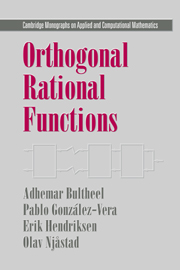Book contents
- Frontmatter
- Contents
- List of symbols
- Introduction
- 1 Preliminaries
- 2 The fundamental spaces
- 3 The kernel functions
- 4 Recurrence and second kind functions
- 5 Para-orthogonality and quadrature
- 6 Interpolation
- 7 Density of the rational functions
- 8 Favard theorems
- 9 Convergence
- 10 Moment problems
- 11 The boundary case
- 12 Some applications
- Conclusion
- Bibliography
- Index
4 - Recurrence and second kind functions
Published online by Cambridge University Press: 22 October 2009
- Frontmatter
- Contents
- List of symbols
- Introduction
- 1 Preliminaries
- 2 The fundamental spaces
- 3 The kernel functions
- 4 Recurrence and second kind functions
- 5 Para-orthogonality and quadrature
- 6 Interpolation
- 7 Density of the rational functions
- 8 Favard theorems
- 9 Convergence
- 10 Moment problems
- 11 The boundary case
- 12 Some applications
- Conclusion
- Bibliography
- Index
Summary
One might expect that, if there exist Szegő style recurrence relations for the reproducing kernels, then it should be possible to derive recurrence relations in the Szegő style for the orthogonal functions themselves. However, deriving these is not as simple as for the reproducing kernels, in the sense that the transition matrices that give the recurrence are not precisely J-unitary, but it is still possible to get some recurrences that coincide with the Szegő recurrence in the polynomial case. This will be done in the first section of this chapter.
Related to this recurrence are the so-called functions of the second kind. They are also solutions of the same recurrence but with different initial conditions. Because they will be important in obtaining several interpolation properties, we shall study them in some detail in Section 4.2.
General solutions of the recurrence, which are linear combinations of first and second kind functions, are then treated in Section 4.3 and we include there an analog of Green's formula. The latter will be used in Chapter 10 on moment problems.
Since the convergents of a continued fraction are linked by a three-term recurrence relation, there is a natural link between three-term recurrence relations and continued fractions. This is explained in Section 4.4.
Finally, Section 4.5 gives some remarks about the situation when not all the points αk are in O, but when they are arbitrarily distributed in O \ ∂O. The case where they are all on ∂O is discussed in Chapter 11.
- Type
- Chapter
- Information
- Orthogonal Rational Functions , pp. 74 - 105Publisher: Cambridge University PressPrint publication year: 1999



